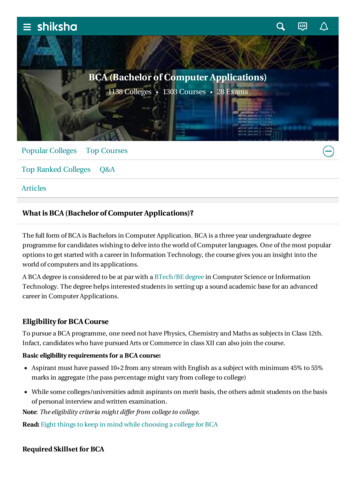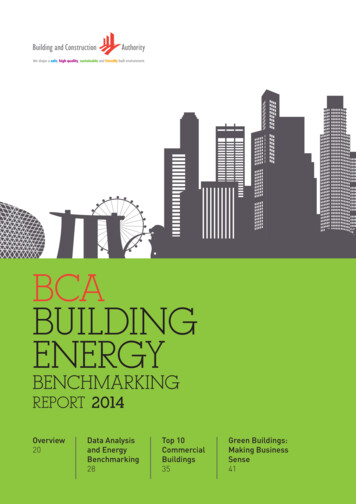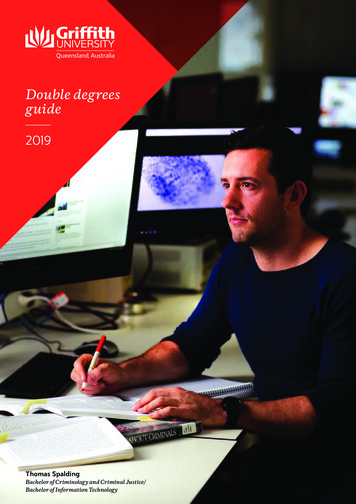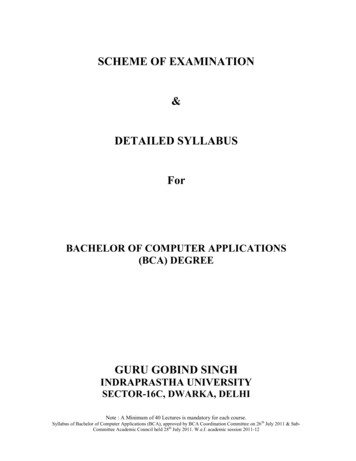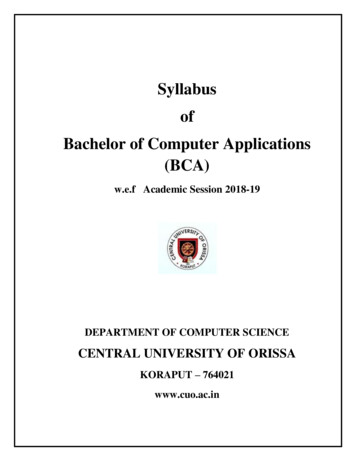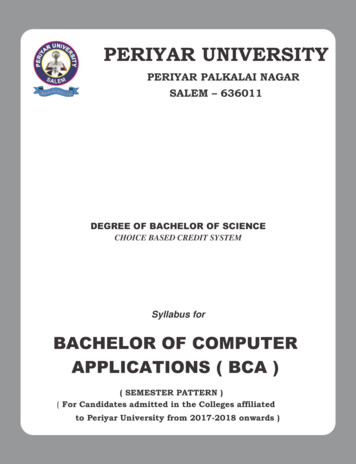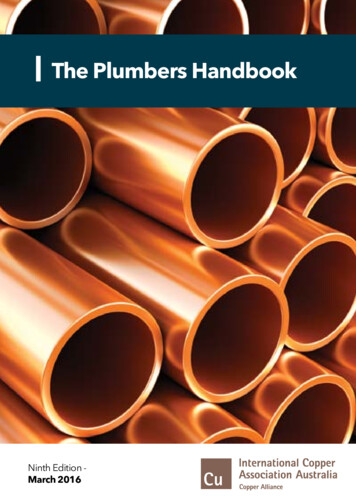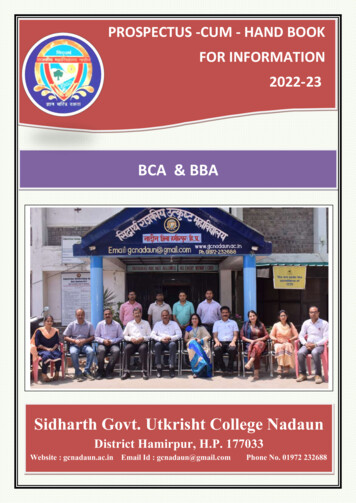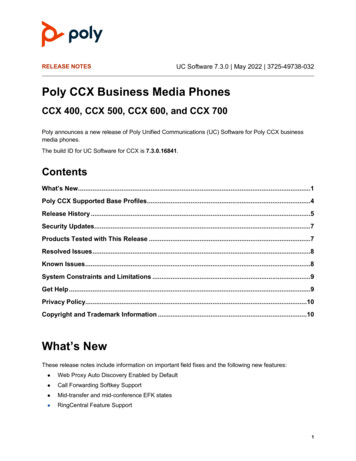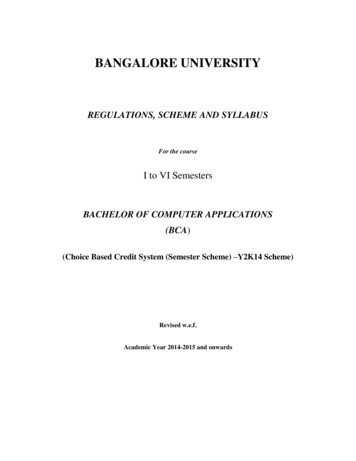
Transcription
BANGALORE UNIVERSITYREGULATIONS, SCHEME AND SYLLABUSFor the courseI to VI SemestersBACHELOR OF COMPUTER APPLICATIONS(BCA)(Choice Based Credit System (Semester Scheme) –Y2K14 Scheme)Revised w.e.f.Academic Year 2014-2015 and onwards
Regulations, Scheme of study and Examination for BCA Degree CourseUnder Choice Based Credit System - Semester System (Y2K14 SCHEME)(Revised w.e.f. 2014 -2015)R 1.a)Title of the course: Bachelor of Computer Applicationsb)Duration of the Course: Durations of the undergraduate programmes shall extendover FOUR semesters (TWO academic years) for the Associate Degree(AdvanceDiploma), SIX semesters (Three academic years) for the regular Bachelor Degree.c).Scheme of study:i) There shall be five theory papers and two practical from first semester to fourthsemester.ii) There will be five theory, two practical and one project in fifth semester. Therewill be four theory, one practical and one project in sixth semester.iii) The project work shall be carried out either independently or jointly(maximum of three students)iv) Medium of Instruction: The medium of instruction shall be English.d)Scheme of Examination:At the end of each semester there be University Examination of three hoursduration in each of the theory paper/practical.R. 2.Each semester shall be of 4 months durationR. 3.Attendance: As per Bangalore University regulations I n force for science degreecourses.R. 4.A Candidate is allowed to carry over all the previous uncleared (failed) theorypapers/Practical to subsequent semesters as per Bangalore University regulationsin force for science degree courses.R. 5.The maximum period for completion of the course shall be six years form the dateof admission.R. 6.Eligibility for admission:a) A candidate who has passed the two years Pre-University Examinationconducted by the Pre-University Education Board in Karnataka
b) A candidate who has passed JODC / Three years Diploma in Engineering ofGovernment of Karnataka or any other examination considered as equivalentthereto shall be eligible for admission.a) Any student who has passed PUC –II Science, Arts or Commerce securing aminimum of 35% OF MARKSORb) Any student who has passed JODC or Diploma in Engg. (of three yearduration of Govt. of Karnataka) with minimum of 35% of marks in aggregatein all the semester /years.R. 7. Admission Procedure:a) Through Counseling in respective collegesb) 50% weight age for entrance test in respective collegesc) 50% weight age for performance at qualifying examination.d) Merit list shall be prepared based on item No, 7(b) and 7(c)e) Reservation: As per the notification /Govt. orders form the University /Govt.from time to time.f) Tuition and other fees: As fixed by the University from time to timeR8. The total number of students to be admitted to the course shall be decided by theUniversity.R9. Results: Results of candidate shall be declared and the classes awarded as per theprocedure followed by the University for B.Sc. Courses.R10. POWER TO REMOVE DIFFICULTIES1) If may difficulty arises in giving effect to the provisions of these regulations, the ViceChancellor may be order make such provisions not inconsistent with the Act, Statutes,Ordinances or other Regulations, as appears to be necessary to expedient to remove thedifficulty.2) Every order made under this shall be subject to rectification by the appropriateUniversity Authorities.
Title of Papers and Scheme of Study & Examination for BCA (Bachelor ofComputer Applications) Under Choice Based Credit System - Semester System(Revised w.e.f. 2014-2015)SemesterPartPart - 03PBCA104PPart – 3BCA201TPart – 1BCA202TBCA203TPart – 2BCA204TIIPart - 2Part - 3Part - 1BCA205TBCA203PBCA204TBCA301TBCA302TBCA303TIIIPart - 2Part - 3Part - 1IVPart - 2Part - BCA404TBCA405TBCA403PBCA404T-Title of the paperHours/ Week IAIndian LanguageEnglishProblem SolvingTechniques using CDigital ElectronicsDiscrete MathematicsC Programming LabDigital Electronics LabFoundation CourseCC & ECIndian LanguageEnglishData structuresDatabase ManagementSystemNumerical and StatisticalMethodsData Structures LabDBMS LabFoundation CourseCC & ECIndian LanguageEnglishObject OrientedProgramming using C Financial Accountingand ManagementOperating SystemC LabAccounting Package LabFoundation CourseCC & ECIndian LanguageEnglishVisual ProgramingUnix Shell programmingOperation ResearchVisual Programming LabUNIX LabSkill DevelopmentCourseCC & ECPage 5 of 38MarksExam Total8010080100CreditsSubject -50116161616
2120030067010023BCA601TBCA602TBCA603TPart – 350Skill tProject WorkBCA504PPart - 3TotalBCA605PBCA505T-Page 6 of rksIAData Communication andNetworksSoftware EngineeringComputer ArchitectureJava ProgrammingMicroprocessor andAssembly LanguageJava Programming LabAssembly LanguageProgramming LabProjectSkill DevelopmentCourseTheory of ComputationSystem ProgrammingCryptography andNetwork SecurityWeb ProgrammingWeb Programming LabBCA501TPart - 2Title of the paperHours/Week30Semester2020
FIRST SEMESTER BCABCA101T : INDIAN LANGUAGESyllabus as per the one prescribed for science courses of Bangalore University.BCA102T : ENGLISHSyllabus as per the one prescribed for science courses of Bangalore University.BCA103T : PROBLEM SOLVING TECHNIQUES USING CTotal Teaching Hours : 60No of Hours / Week : 04Unit - IIntroduction to Programming Concepts: Software, Classification of Software, ModularProgramming, Structured Programming, Algorithms and Flowcharts with examples.Overview of C Language: History of C, Character set, C tokens, Identifiers, Keywords,Data types, Variables, Constants, Symbolic Constants , Operators in C, Hierarchy ofOperators, Expressions, Type Conversions and Library Functions.[12 Hours ]Unit - IIManaging Input and Output Operation: Formatted and Unformatted I/O Functions,Decision making, branching and looping: Decision Making Statements - if Statement, if–else statement, nesting of if-else statements, else–if ladder, switch statement,?: operator,Looping - while, do-while, for loop, Nested loop, break, continue, and goto statements.Functions: Function Definition, prototyping, types of functions, passing arguments tofunctions, Nested Functions, Recursive functions.[12 Hours ]Unit - IIIArrays: Declaring and Initializing, One Dimensional Arrays, Two Dimensional Arrays,Multi Dimensional Arrays - Passing arrays to functions. Strings: Declaring andInitializing strings, Operations on strings, Arrays of strings, passing strings to functions.Storage Classes - Automatic, External, Static and Register Variables.[12 Hours ]Unit-IVStructures-Declaring and Initializing, Nested structure, Array of Structure, PassingStructures to functions, Unions, typedef, enum, Bit fields. Pointers – Declarations,Pointer arithmetic, Pointers and functions, Call by value, Call by reference, Pointers andArrays, Arrays of Pointers, Pointers and Structures. Meaning of static and dynamicmemory allocation, Memory allocation functions.[ 12 Hours ]Unit-VFiles - File modes, File functions, and File operations, Text and Binary files, CommandLine arguments. C Preprocessor directives, Macros – Definition, types of Macros,Creating and implementing user defined header files.[ 12 Hours ]TEXT BOOKS1. E. Balaguruswamy, “Programming In ANSI C”, 4th edition, TMH Publications,20072. Ashok N. Kamthane, “Programming with ANSI and Turbo C”, Pearson Education,2006REFERENCES BOOKSPage 7 of 38
Ashok N. Kamthane et. al., “Computer Programming and IT”, Pearson Education,20112. Mahapatra, “ Thinking In C ”, PHI Publications, 1998.3. Yashwant Kanetkar, “Let Us C”, 13th Edition, PHP, 2013.1.BCA104T: DIGITAL ELECTRONICSTotal Teaching Hours : 60No of Hours / Week : 04Unit - IIntroduction to network theorems and AC fundamentals: Ohm’s law: Statement,explanation. Kirchhoff’s law: Statement & explanation of KCL and KVL. Mesh/loopanalysis (up to 2 loops) and node voltage method, Numerical problems. Delta/star andstar/Delta transformation: No derivation for Interco version equations, introduction ofnetwork, port of network (one port network, two port network), unilateral network,bilateral network, linear network. Need for application of network theorems. (DCCircuits only). Superposition theorem: statement, (only with TWO voltage sources) stepsto apply the theorem explanation by considering a simple resistive network andproblems. Thevenin’s theorem: Statement, (Only with ONE voltage source) Steps toapply the theorem, explanation by considering a simple resistive networking andproblems. Norton’s theorem: Statement, (Only with ONE voltage source) steps to applythe theorem, explanation by considering a simple resistive network and problems.Maximum power transfer theorem: Statement, explanation of theorem by considering asimple resisting network, expression for maximum power deliver (P L (max) Vth2/4Rth) (no derivation), graph of Vs Pl, numerical problems and applications.Reciprocity theorem, Statement, explanation using resistive network with dc source andnumerical problems. AC Fundamentals: Representation of ac sine wave, instantaneousvalue, peak value, peak to peak value, average value, r.m.s value cycle, time period,frequency. (No derivations, only mention the expressions) Representation of nonsinusoidal waves.[ 12 Hours ]Unit - IISemiconductor Devices: Introduction, atomic structure, energy level, energy banddiagram in solids, classification of conductors, insulators and semiconductors.Semiconductor, properties, crystal structure of semiconductor, types – intrinsic andextrinsic semiconductor. Intrinsic semiconductor: Crystal structure (Ge& Si), thermalgenerated charges (electron and holes) carriers the effect temp on their motion. Extrinsicsemiconductor: Doping, donor acceptor impurities, c-type, p-type semiconductor,majority and minority carriers, their currents, concept of immobile ions. Semiconductordevices : PN junction diode, formation of pn junction layer, potential barrier, energylevel diagram of pn junction, Biasing of pn junction, behaviour of pn junction underforward and reverse biasing, break down in pn junction, avalanche and zener breakdown. Diode characteristics; V-I characteristic, forward and reverse bias, diodeparameters, bulk resistance, knee voltage, static and dynamic resistance, PIV.Application of diode; As a rectifier, as logic gate, as a switch, etc. Rectifier, types, Halfwave Full wave. Half wave rectifier: Circuit, working, wave forms and expression forripple factor and efficiency (no derivation), advantages & disadvantages. Bridge waverectifier: Circuit, working, wave forms and expressions for ripple factor and efficiently(no derivation), advantages & disadvantages. Logic families: Scale of integration, DigitalIC’s, classifications, DTL, TTL, ECL, MOS, CMOS, Mention of features: speed ofoperation, power dissipation, propagation delay, fan-in, fan-out.[ 12 Hours ]Page 8 of 38
Unit – IIINumber Systems: Introduction to number systems – positional and non-positional, Base/Radix. Decimal number system-Definition, digits, radix/base, Binary number system –Bit Byte, Conversions: Binary to Decimal and Decimal to Binary. Octal number systemConversion from Octal to Decimal to Octal, Octal to Binary and binary to Octal.Hexadecimal number system –Conversion : Decimal to Hex, Hex to decimal, Hex toBinary, Binary to Hex, Octal to Hex, Hex to Octal, Binary, arithmetic –binary addition,subtraction, multiplication and division (only Integer part). 1’s and 2’s compliment: 2’scomplement subtraction. Binary code: BCD numbers, 8421 code, 2421 code- examplesand applications. Gray code –Conversions-Gray to binary and Binary to Gray,application of gray code (Mention only). Excess-3 code – self complimenting propertyand applications. Definition and nature of ASCII code. Introduction to error detectionand correction code, parity check. Boolean algebra:-Laws and theorems. AND, OR,NOT Laws, Commutative law, associative law, distributive law, Duality theorem.Demorgan’s theorems-Statements, proof using truth tables; Simplification of Booleanexpressions using Boolean laws. Definition of product term, sum term, minterm,maxterm, SOP, standard POS and Standard POS. Conversion of Boolean expression toStandard SOP and Standard POS forms. Karnaugh maps-Definition of Karnaugh map,K- map for 2, 3 and 4 variables. Conversion of truth tables into k-map grouping of cells,redundant groups and don’t care conditions Karnaugh map technique to solve 3 variableand 4 variable expressions. Simplification of 3 and 4 variable Boolean expression usingK-maps (SOP only)[ 12 Hours ]Unit - IVLogic Gates: AND Gate: Definition, symbol truth table, timing diagram, Pin diagram ofIC 7408. OR Gate: Definition, symbol, truth table, timing diagram of IC 7432. NOTGate: Definition symbol, truth table, timing diagram, Pin diagram of IC 7404. NANDGate: Definition, symbol, truth table, Pin diagram of IC 7400, NOR Gate: Definition,symbol, truth table, timing diagram, Pin diagram of IC 7402. Exclusive OR Gate:Definition, symbol, truth table, timing diagram. Combinational logic circuits: Definition,applications. Half Adder: Symbol, Logic circuits using XOR and basic gates, Truth table,Full Adder: Symbol, Logic circuits using XOR and basic gates, Truth table, HalfSubtractor: Symbol, Logic circuits using XOR and basic gates, Truth table. FullSubtractor: Symbol, Logic circuits using XOR and basic gates, Truth table. Adder –Subtractor; Logic circuit, Pin diagram IC 7483, IC 7486. Parallel Adder: 4 –bit parallelbinary adder, BCD adder, IC 7483 NAND –NOR implementation of Adders.[ 12 Hours ]Unit - VSequential Circuits: Importance of clock in digital circuit and introduction to flip flop.Flip –flop-difference between latch and flip-flop. Qualitative study of level and edgetriggering. RS latch /unlocked, symbol and truth table. RS flip-flop using NAND gate,symbol, truth table and timing diagram. D flip –flop – Symbol, truth table, Realization ofJK flip –flop using NAND gates, working, and timing diagram. Race around condition,present and clear inputs, pin diagram of IC 74112. T flip flop-Logic symbol, JK flip flopas a T flip –flop truth table and timing diagram. Master slave flip flop;Logic circuit,truth table and timing diagram, advantage of M/S flip-flop, pin diagram of IC 7473 IC7476. Registers: Definition, types of registers-Serial in serial out, serial in parallel out,Parallel in serial out, Parallel in parallel our shift register (Block diagram representationfor each), truth table, timing diagram and speed comparison.[ 12 Hours ]Page 9 of 38
Text Books:1) Thomas L.Floyd ,’’Digital Fundamentals”, Peason Education Inc, New Delhi,2003Reference Books:1) Morris Mano, “Digital Design”, 5Th Edition, Prentice Hall, 20132) R.P.Jain, “Modern Digital Electronics”, 3rd Edition, Tata Mc Graw Hill, 2003.3) Bignell and Donovan, “Digital Electronics”, 5th Edition, Thomson Publication,2007.BCA105T: DISCRETE MATHEMATICSTotal Teaching Hours: 65No of Hours / Week: 05Unit – ISets, Relations and Functions: Sets, Subsets, Equal Sets, Universal Sets, Finite andInfinite Sets, Operation on Sets, Union, Intersection and Complements of Sets, CartesianProduct, Cardinality of Set, De-mogan’s law, Simple Applications. Relations, Propertiesof Relations, Equivalence Relation, Function: Domain and Range, Onto, Into, One toOne, one to many Functions, Composite and Inverse Functions. Mathematical Logic:Proposition and truth values, Logical Connectives and their truth tables, Converse,Inverse and Contrapositive, Tautology and Contradiction, Logical Equivalence –Standard Theorems, Switching Circuits.[ 13 Hours ]Unit - IIMatrices: Review of fundamentals: Definition of matrix, order, Types of matrices: zero,row, column, square, diagonal, scalar, unit, symmetric, skew-symmetric. Determinant:Value of determinant of order 2x2, 3x3, minors, cofactors, adjoint, inverse of a matrix.Solutions of linear equations: Cramers rule and matrix method involving two and threevariables. Eigen values and Eigenvectors: Characteristic equation, characteristic roots,characteristic vectors (without any theorems) only 2x2 order. Cayley Hamilton theorem.(Only statement), verification of Cayley Hamilton theorem (only 2x2 matrices), using thesame finding the powers of A (A4, A5, A-1, A-2), Inverse of a Matrix using CayleyHamilton theorem.[ 13 Hours ]Unit - IIILogarithms: Definition of Logarithm, Indices leading to Logarithms and vice versa, Lawsof Logarithms with proofs, Problems, Common Logarithm: Characteristic and Mantissa,Use of Logarithmic Tables, Problems. Permutation and Combination: FundamentalPrinciple of Counting, Factorial n, Permutations: Definition, Examples, Derivation ofFormula nPr, Permutation when all the objects are not distinct, Problems, Combinations:Definition, examples, Proving nCr nPr r!, nCr nCn-r, nCr nCr-1 n 1Cr , Problemsbased on above formulae.[ 13 Hours ]Unit - IVGroups: Binary operation, Define of group, properties (only statement), problems (bothfinite and infinite groups), subgroup, theorems (no proof), problems. Vectors: Definitionof vector and scalar, vector addition, dot and cross product, projection of a vector on theother (no geometrical meaning), area of parallelogram, area of a triangle, scalar tripleproduct, volume of parallelepiped, co planarity of three vectors, vector triple product.[ 13 Hours ]Page 10 of 38
Unit - VAnalytical Geometry in Two Dimensions: Coordinates, Distance formula, SectionFormula, Area of the Triangle formula (no derivation), Locus of point. Straight Line:Slope of a line and angle between two lines, Various forms of equations of lines –Derivation and Problems. Equation of family of lines passing through the point ofintersection of two lines, Distance of a point from line (only problems).[ 13 Hours ]Text Books1. Grewal, B.S.Higher engineering Mathematings, 36th EditionReference Books1. Satyrs S.S, Engineering Mathematics.2. Peter V.O’Neil. Advanced Engineering Mathematics, 5th Edition.BCA103P: C PROGRAMMING LABPART – A1) Write a C Program to find the roots of the given quadratic equation using if-else ifstatement.2) Write a menu driven C program using switch-case to find: (a) Sum of the digits ofnumber (b) Factorial of N.3) Write a C program to find cos (x) using series cos(x) 1 – x2/2! x4/4! xn/n! ]4) Write a Program to find whether a given number is prime number are not5) Write a C program to arrange the given set of numbers in ascending anddescending order.6) Write a C program to find product of two N x M matrices.7) Write a C program to calculate NCR N!/ R! * (N-R)! Using function.8) Write a C program to display Fibonacci series using recursive function.9) Write a C program to concatenate two strings using pointers.10) Write a C program to copy content of one file to another file.PART – BDuring practical examination the External and Internal examiners may prepare examquestion paper related to theory syllabus apart from Part-A. (A minimum of 10Programs has to be prepared).Note :a) The candidate has to write both the programs One from Part-A and other fromPart-B and execute one program as of External examiner choice.b) A minimum of 10 Programs has to be done in Part-B and has to be maintained inthe Practical Record.c) Scheme of Evaluation is as follows:Writing two programs- 10 MarksExecution of one program- 10 MarksFormatting the Output- 05 MarksViva- 05 MarksRecord- 05 MarksTotal- 35 MarksBCA104P: DIGITAL ELECTRONICS LAB1. Study of Logic Gates–AND, OR, NOT, NAND, NOR XOR(Using respective ICs)2. Realization of AND, OR and NOT gates using Universal Gates.Page 11 of 38
3.4.5.6.7.8.9.10.Design and Realization of Half Adder/Subtracted using NAND Gates.Design and Realization of Full Adder using Logic Gates.Design and Realization of 4 bit Adder/Subtractor using IC 7483.Design and Realization of BCD Adder using IC 7483.Realization of J-K flip flop using IC 7400 and 7410.Realization of T and D flip flop using IC 7476.Implementation of PIPO Shift Registers using flip flops. (IC 7476).Design and implementation of odd and even parity checker Generator usingIC 74180.PART – BDuring practical examination the External and Internal examiners may prepare examquestion paper related to theory syllabus apart from Part-A. (A minimum of 10Programs has to be prepared).Note :a) The candidate has to write both the programs One from Part-A and other fromPart-B and execute one program as of External examiner choice.b) A minimum of 10 Programs has to be done in Part-B and has to be maintained inthe Practical Record.c) Scheme of Evaluation is as follows:Writing two programs- 10 MarksExecution of one program- 10 MarksFormatting the Output- 05 MarksViva- 05 MarksRecord- 05 MarksTotal- 35 MarksSECOND SEMESTER BCABCA201T: INDIAN LANGUAGESyllabus as per the one prescribed for science courses of Bangalore University.BCA202T: ENGLISHSyllabus as per the one prescribed for science courses of Bangalore University.BCA203T: DATA STRUCTURESTotal Teaching Hours : 60No of Hours / Week : 04Unit-IIntroduction and Overview: Definition, Elementary data organization, Data Structures,data structures operations, Abstract data types, algorithms complexity, time-spacetradeoff. Preliminaries: Mathematical notations and functions, Algorithmic notations,control structures, Complexity of algorithms, asymptotic notations for complexity ofalgorithms. String Processing: Definition, Storing Stings, String as ADT, Stringoperations, word/text processing, Pattern Matching algorithms.[ 12 Hours ]Unit-IIArrays: Definition, Linear arrays, arrays as ADT, Representation of Linear Arrays inMemory, Traversing Linear arrays, Inserting and deleting, Sorting: Bubble sort, Insertionsort, Selection sort, Searching: Linear Search, Binary search, Multidimensional arrays,Page 12 of 38
Matrices and Sparse matrices.[ 12 Hours ]Unit-IIILinked list: Definition, Representation of Singly linked list in memory, Traversing aSingly linked list, Searching a Singly linked list, Memory allocation, Garbage collection,Insertion into a singly linked list, Deletion from a singly liked list; Doubly liked list,Header liked list, Circular linked list.[ 12 Hours ]Unit-IVStacks – Definition, Array representation of stacks, Linked representation of stacks,Stack as ADT, Arithmetic Expressions: Polish Notation, Application of Stacks,Recursion, Towers of Hanoi, Implementation of recursive procedures by stack. Queues– Definition, Array representation of queue, Linked list representation of queues Typesof queue: Simple queue, Circular queue, Double ended queue, Priority queue, Operationson Queues, Applications of queues.[ 12 Hours ]Unit-VGraphs: Graph theory terminology, Sequential representation of Graphs: Adjacencymatrix, traversing a Graph. Tree – Definitions, Binary trees, Representing binary trees inmemory, Traversing Binary Trees, Binary Search Trees, Searching, Inserting andDeleting in a Binary Search Tree.[ 12 Hours ]TEXT BOOKS1. Seymour Lipschutz, “Data Structures with C”, Schaum’s outLines, TataMcGraw-Hill, 2011.REFERENCES BOOKS1. Mark Allen Weiss, “Data Structures and Algorithm Analysis in C”, SecondEdition, Pearson Education, 2013.2. Robert Kruse, C.L.Tondo, Bruce Leung, Shashi Mogalla, “Data Structures andProgram Design using C”, Pearson Education, 2009.3. Forouzan, “A Structured Programming Approach using C”, 2nd Edition, CengageLearning India, 2008.BCA204T : DATA BASE MANAGEMENT SYSTEMSTotal Teaching Hours : 60No of Hours / Week : 04Unit - IIntroduction: Database and Database Users, Characteristics of the Database Approach,Different people behind DBMS, Implications of Database Approach, Advantages ofusing DBMS, When not to use a DBMS. Database System Concepts and architecture:Data Models, Schemas, and Instances. DBMS Architecture and Data Independence.,Database languages and interfaces. The database system Environment, Classification ofDBMS.[ 12 Hours ]Unit - IIData Modelling Using the Entity-Relationship Model: High level conceptual DataModels for Database Design with and example., Entity types, Entity sets, attributes, andKeys, ER Model Concepts, Notation for ER Diagrams, Proper naming of SchemaConstructs, Relationship types of degree higher than two. Record Storage and PrimaryFile Organization: Secondary Storage Devices. Buffering of Blocks. Placing file Recordson Disk. Operations on Files, File of unordered Records (Heap files), Files of OrderedPage 13 of 38
Records (Sorted files), Hashing Techniques, and Other Primary file Organization.[ 12 Hours ]Unit - IIIFunctional Dependencies and Normalization for Relational Database: Informal DesignGuidelines for Relational schemas, Functional Dependencies, Normal Forms Based onPrimary Keys., General Definitions of Second and Third Normal Forms Based onPrimary Keys., General Definitions of Second and Third Normal Forms, Boyce-CoddNormal Form. Relational Data Model and Relational Algebra: Relational ModelConcepts., relational Model Constraints and relational Database Schema, definingRelations, Update Operations on Relations., Basic Relational Algebra Operations,Additional Relational Operations., Examples of queries in the Relational Algebra.,Relational Database design Using ER-to-Relational Mapping.[ 12 Hours ]Unit – IVRelational Database Language: Data definition in SQL, Queries in SQL, Insert, Deleteand Update Statements in SQL, Views in SQL, Specifying General Constraints asAssertions, specifying indexes, Embedded SQL. PL /SQL: Introduction.[ 12 Hours ]Unit - VTransaction Processing Concepts: Introduction, Transaction and System Concepts,Desirable properties of transaction, Schedules and Recoverability, Serializability ofSchedules, Transaction Support in SQL, Locking Techniques for Concurrency Control,Concurrency Control based on time stamp ordering.[ 12 Hours ]Text book:1. Remez Elmasri and Shamkant B. Navathe, “Fundamentals of Database Systems”,5th Edition, Pearson Education, 2007.References:1. Abrahamsi. Silberschatz, Henry. F. Korth, S. Sudarshan, “Database SystemConcepts” 6th Edition, McGraw Hill, 2012.2. C.J.Date, “Introduction to database systems”, Eight Edition, Addison Wesley,2003.BCA205: NUMERICAL AND STATISCAL METHODSTotal Teaching Hours: 65No of Hours / Week : 05Unit - IFloating-point representation and errors-Normalized floating-point forms, Errors inrepresenting numbers, Floating point machine number and machine epsilon, Loss ofsignificance and its avoidance. Roots of equations-locating roots of f(x) 0 Bisectionmethod, Newton’s method, Secant method.[ 13 Hours ]Unit - IIInterpolation and numerical differentiation-polynomial interpolation, Lagrange andNewton form of interpolating Polynomial, Divided difference and recursive property,Inverse interpolation, First and Second derivative formulae via interpolationPolynomials. Numerical integration-Trapezoidal, Simpson’s and adaptive Simpson rules.[ 13 Hours ]Unit - IIISystem of linear equations-Gaussian elimination and back substitution-partial andcomplete pivoting, Doolittle, Cholesky and Crout LU decomposition methods, Jacobi andPage 14 of 38
Gauss – Seidel iterative methods. Power (and inverse power) method of obtaining largest(smallest) eigenvalue and corresponding eigenvector. Ordinary differential equationsinitial value problem, Picard’s, Taylor series, Runge-Kutta first, second and fourth ordermethods.[ 13 Hours ]Unit – IVBasics concepts and definition of statistics. Mean, Standard deviation, coefficient ofVariation, skewness & kurtosis, Carl Pearson Correlation, Rank correlation andillustrated examples. Probability: Basic concept and definition of probability, probabilityaxioms, Laws of Probability, Conditional probability, Bayes theorem , Problems andapplication.[ 13 Hours ]Unit - VRandom variable and Expectation:Discrete and continuous random variables,expectation of random variables, theorems on expectation, illustrative examples.Probability Distribution: Probability function, Probability mass/density function,Discrete Distribution – Bernoulli, Binomial Distribution, Continuous distribution –Normal Distribution, applications and problems.[ 13 Hours ]Text Books:1. M.K.Jain, SRK Iyengar and R.K. Jain Numerical methods for Scientific andEngineering Computation: Wiley Eastern.2. Ronald E Walpole & Raymond H Meyers : Probability & Statistics forEngineers and Scientists (Second Edition).References1. J.Medhi : Statistical Methods New Age Publications.2. S.C.Gupta and V.K.Kapoor – Elements of Mathematics, Statistics,Sultan Chand and Sons.BCA203P : DATA STRUCTURES USING C LABPART - A1. Write a menu driven C program to perform the following string operations withoutusing string functions: (i) String Length (ii) String Concatenation (ii) StringReverse2. Write a C program to search for an element in an array using Binary search3. Write a C program to sort a list of N elements using Selection Sort Algorithm.4. Write a C program to construct a singly linked list and perform insertion, deletionand Display operations.5. Write a C program to demonstrate the working of stack using liked list.6. Write a C program for Towers of Hanoi problem.7. Write a C program to find GCD of two numbers using recursion8. Write a C program to convert infix arithmetic expression to post fix expression.9. Write a C program to simulate the working of Circular Queue using an array.10. Write a C program to create and traverse a binary search tr
BCA103P C Programming Lab 3 15 35 50 1 BCA104P Digital Electronics Lab 3 15 35 50 1 Part – 3 - Foundation Course 3 30 70 100 2 - CC & EC 50 50 1 II Part – 1 BCA201T Indian Languag
